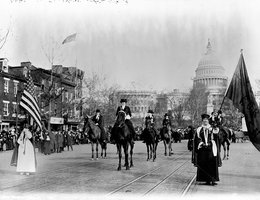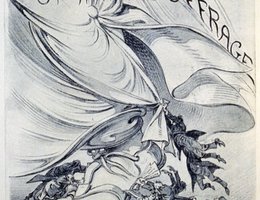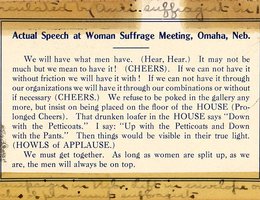

Opposition to the cause of women’s suffrage began informally but gradually organized. Ironically, some of most vocal opposition to votes for women came from . . . well, women. How could this be?
Perhaps, some women opposed suffrage because they were afraid they would have to give up something valuable in return for the right to vote. Some women felt that they occupied a sheltered and valued position in their homes and that voting outside the home would break that family bond. A pamphlet, entitled, "Ten Reasons That the Great Majority of Women Do Not Want the Ballot" claimed that:
"Fathers, husbands, sons and brothers . . . afford full protection to the community, there being no call for women to relieve them of the task." The Omaha Association Opposed to Women Suffrage also noted that voters are required to serve on juries. Therefore, women would be "compelled to hear all the repugnant details incident to murder trials and trials for other crimes disclosing unspeakable wickedness. Jury service is abhorrent to every normal woman."
Other anti-suffragists clung to Victorian ideals and feared that the social change that suffrage would bring would also bring a loss of privileges and protection women had been given as a result of being the "weaker sex". Suffrage would cause men to fail to support dependent women, cause a dramatic increase in divorce rates, and force women into the labor market. Political responsibilities would overburden already busy women. And the image of the "new woman" would destroy the respect and status they enjoyed as wives and mothers.


Some argued that the many philanthropic, charitable, educational and civic activities females performed for society would be lost if they engaged in politics. If a woman became involved in politics, her ability to reform society would be impaired because she would no longer be a disinterested party. Others felt that the females would merely echo the vote of their husbands. Others argued that suffragists were "anti-female, anti-family, and anti-American."
Gradually, these opponents of women’s suffrage organized, but it took an overt act by the pro-suffrage forces to prompt that organization. In 1914, the Nebraska Woman Suffrage group launched an initiative petition campaign to place the issue on the ballot. In response, the Nebraska Association Opposed to Woman Suffrage was founded in Omaha.
Like anti-suffrage associations in other states, the Nebraska association was staffed and run by women, and its membership was overwhelmingly female. The role of men in the Nebraska Association Opposed to Woman Suffrage was marginal. Mrs. E. P. Peck of Omaha became the president and Mary Nash (Mrs. L. F.) Crofoot was named chairwoman of the executive committee.
The women’s anti-suffragists recruited, organized, and raised funds by holding teas, luncheons, and balls at prominent hotels. Their goal was to educate the public about the evils of the suffrage movement. They expressed their views through advertising, literature, and speaking engagements. But in at least one incident, they even used disruptive tactics. Anti-suffragists broke into parades disguised as suffragists and tried to make the proponents of the vote look foolish.
While women may have been on the forefront of the movement to deny women the right to vote, there were religious and male opposition groups as well.